2000 MERCEDES-BENZ SL500 tow
[x] Cancel search: towPage 244 of 297
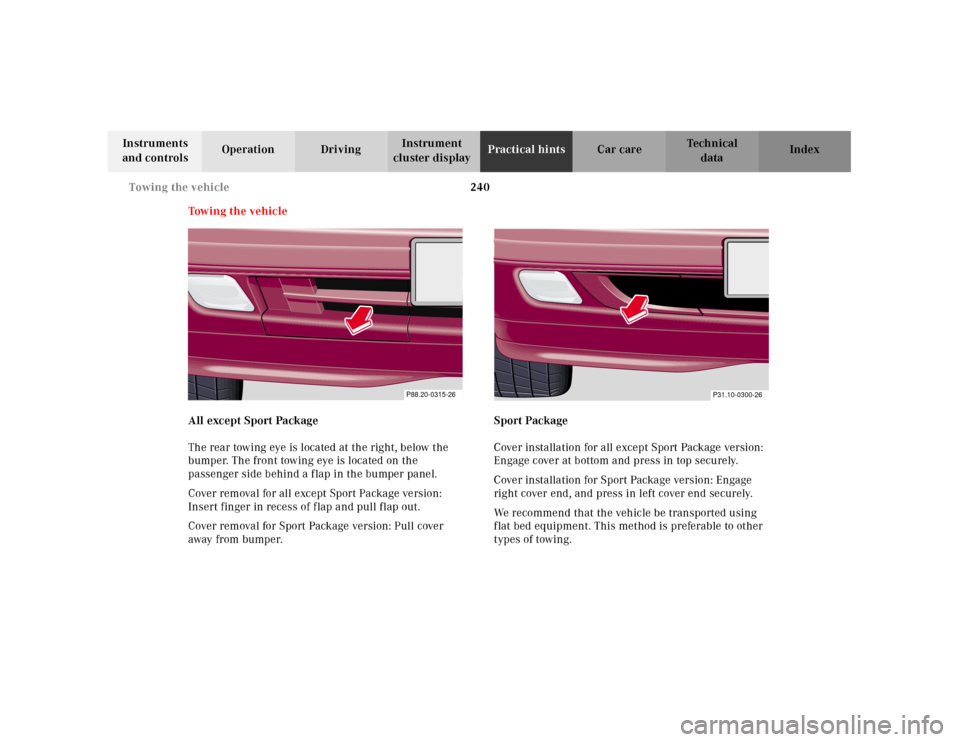
240 Towing the vehicle
Technical
data Instruments
and controlsOperation DrivingInstrument
cluster displayPractical hintsCar care Index
Tow in g th e vehic le
All except Sport Package
The rear towing eye is located at the right, below the
bumper. The front towing eye is located on the
passenger side behind a flap in the bumper panel.
Cover removal for all except Sport Package version:
Insert finger in recess of flap and pull flap out.
Cover removal for Sport Package version: Pull cover
away from bumper.Sport Package
Cover installation for all except Sport Package version:
Engage cover at bottom and press in top securely.
Cover installation for Sport Package version: Engage
right cover end, and press in left cover end securely.
We recommend that the vehicle be transported using
flat bed equipment. This method is preferable to other
types of towing.
P88.20-0315-26
P31.10-0300-26
Page 245 of 297
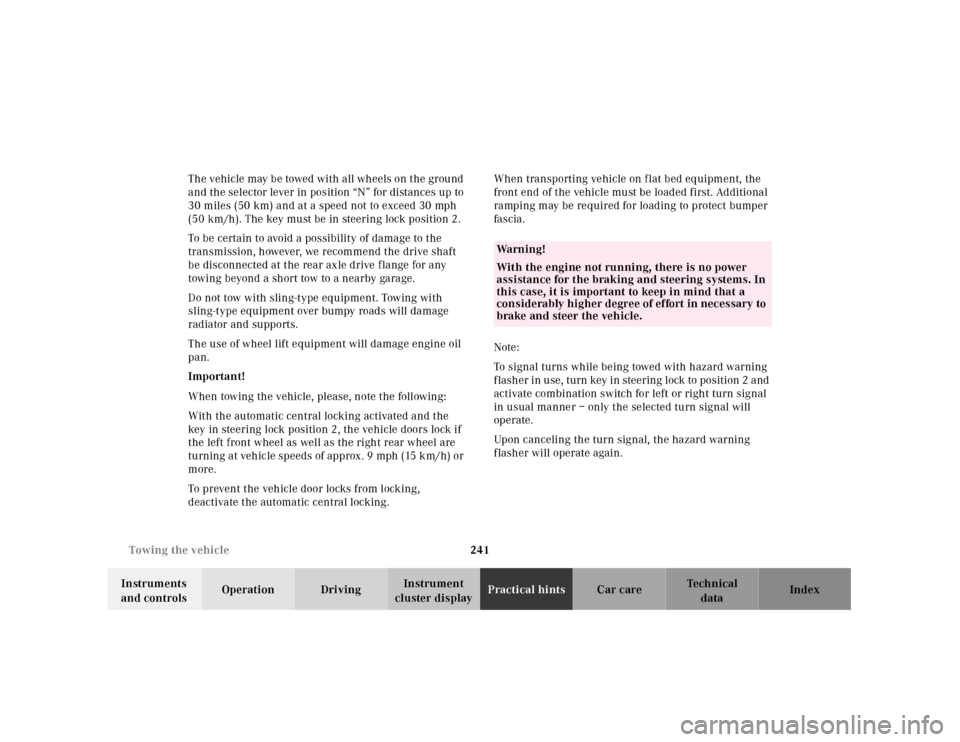
241 Towing the vehicle
Technical
data Instruments
and controlsOperation DrivingInstrument
cluster displayPractical hintsCar care Index The vehicle may be towed with all wheels on the ground
and the selector lever in position “N” for distances up to
30 miles (50 km) and at a speed not to exceed 30 mph
(50 km/h). The key must be in steering lock position 2.
To be certain to avoid a possibility of damage to the
transmission, however, we recommend the drive shaft
be disconnected at the rear axle drive f lange for any
towing beyond a short tow to a nearby garage.
Do not tow with sling-type equipment. Towing with
sling-type equipment over bumpy roads will damage
radiator and supports.
The use of wheel lift equipment will damage engine oil
pan.
Important!
When towing the vehicle, please, note the following:
With the automatic central locking activated and the
key in steering lock position 2, the vehicle doors lock if
the left front wheel as well as the right rear wheel are
tu rning a t veh ic le speeds of approx . 9 mph (15 k m/h) or
more.
To prevent the vehicle door locks from locking,
deactivate the automatic central locking.When transporting vehicle on flat bed equipment, the
front end of the vehicle must be loaded first. Additional
ramping may be required for loading to protect bumper
fascia.
Note:
To signal turns while being towed with hazard warning
f lash er in u se, turn key in steering l ock to position 2 a nd
activate combination switch for left or right turn signal
in usual manner – only the selected turn signal will
operate.
Upon canceling the turn signal, the hazard warning
f lasher will operate again.
Wa r n i n g !
With the engine not running, there is no power
assistance for the braking and steering systems. In
this case, it is important to keep in mind that a
considerably higher degree of effort in necessary to
brake and steer the vehicle.
Page 257 of 297
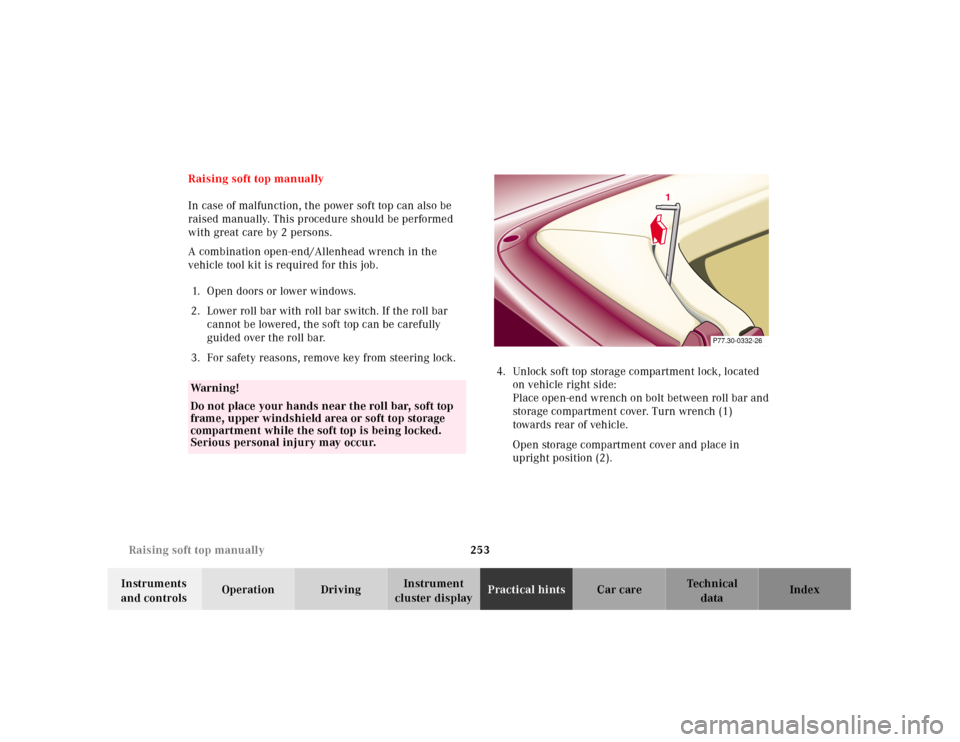
253 Raising soft top manually
Technical
data Instruments
and controlsOperation DrivingInstrument
cluster displayPractical hintsCar care Index Raising soft top manually
In case of malfunction, the power soft top can also be
raised manually. This procedure should be performed
with great care by 2 persons.
A combination open-end/Allenhead wrench in the
vehicle tool kit is required for this job.
1. Open doors or lower windows.
2. Lower roll bar with roll bar switch. If the roll bar
cannot be lowered, the soft top can be carefully
guided over the roll bar.
3. For safety reasons, remove key from steering lock.
4. Unlock soft top storage compartment lock, located
on vehicle right side:
Place open-end wrench on bolt between roll bar and
storage compartment cover. Turn wrench (1)
towards rear of vehicle.
Open storage compartment cover and place in
upright position (2).
Wa r n i n g !
Do not place your hands near the roll bar, soft top
frame, upper windshield area or soft top storage
compartment while the soft top is being locked.
Serious personal injury may occur.
P77.30-0332-26
1
Page 259 of 297
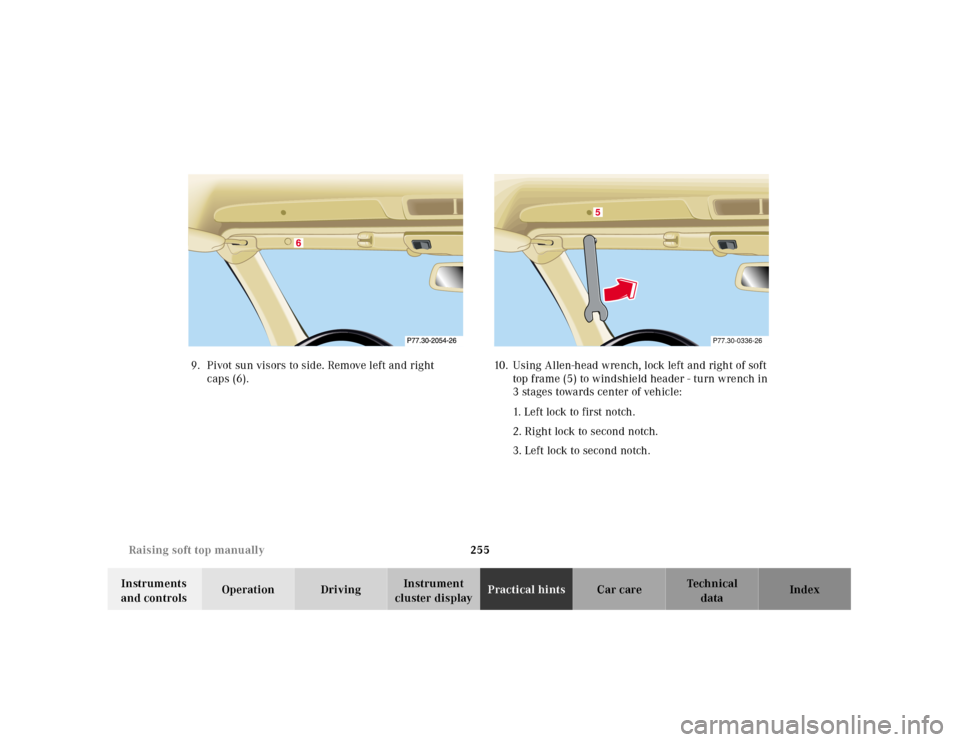
255 Raising soft top manually
Technical
data Instruments
and controlsOperation DrivingInstrument
cluster displayPractical hintsCar care Index 9. Pivot sun visors to side. Remove left and right
caps (6).10. Using Allen-head wrench, lock left and right of soft
top frame (5) to windshield header - turn wrench in
3 stages towards center of vehicle:
1. Left lock to first notch.
2. Right lock to second notch.
3. Left lock to second notch.
P77.30-0336-26
5
Page 260 of 297
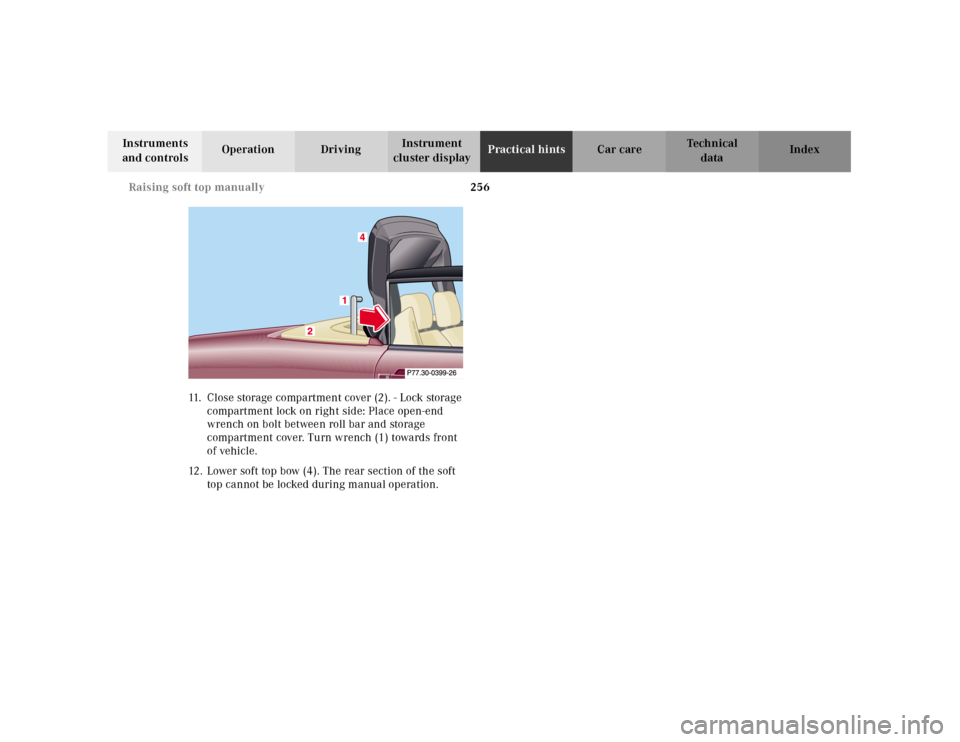
256 Raising soft top manually
Technical
data Instruments
and controlsOperation DrivingInstrument
cluster displayPractical hintsCar care Index
11. Close storage compartment cover (2). - Lock storage
compartment lock on right side: Place open-end
wrench on bolt between roll bar and storage
compartment cover. Turn wrench (1) towards front
of vehicle.
12. Lower soft top bow (4). The rear section of the soft
top cannot be locked during manual operation.
Page 267 of 297
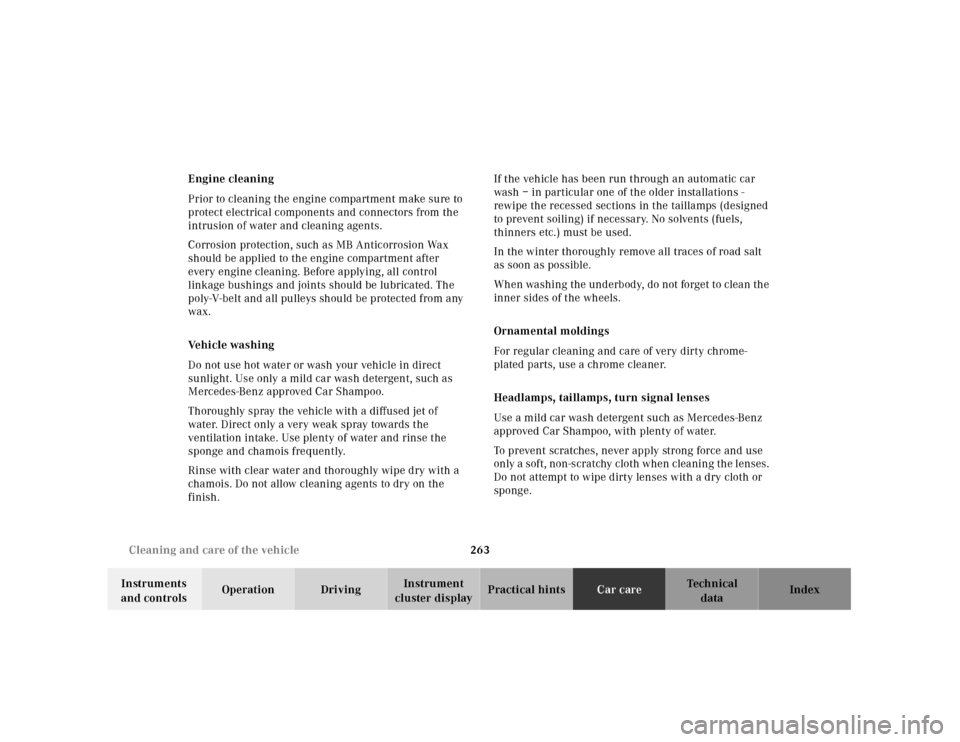
263 Cleaning and care of the vehicle
Technical
data Instruments
and controlsOperation DrivingInstrument
cluster displayPractical hintsCar careIndex Engine cleaning
Prior to cleaning the engine compartment make sure to
protect electrical components and connectors from the
intrusion of water and cleaning agents.
Corrosion protection, such as MB Anticorrosion Wax
should be applied to the engine compartment after
every engine cleaning. Before applying, all control
linkage bushings and joints should be lubricated. The
poly-V-belt and all pulleys should be protected from any
wax.
Ve h i c l e w a s h i n g
Do not use hot water or wash your vehicle in direct
sunlight. Use only a mild car wash detergent, such as
Mercedes-Benz approved Car Shampoo.
Thoroughly spray the vehicle with a diffused jet of
water. Direct only a very weak spray towards the
ventilation intake. Use plenty of water and rinse the
sponge and chamois frequently.
Rinse with clear water and thoroughly wipe dry with a
chamois. Do not allow cleaning agents to dry on the
finish.If the vehicle has been run through an automatic car
wash – in particular one of the older installations -
rewipe the recessed sections in the taillamps (designed
to prevent soiling) if necessary. No solvents (fuels,
thinners etc.) must be used.
In the winter thoroughly remove all traces of road salt
as soon as possible.
When washing the underbody, do not forget to clean the
inner sides of the wheels.
Ornamental moldings
For regular cleaning and care of very dirty chrome-
plated parts, use a chrome cleaner.
Headlamps, taillamps, turn signal lenses
Use a mild car wash detergent such as Mercedes-Benz
approved Car Shampoo, with plenty of water.
To prevent scratches, never apply strong force and use
only a soft, non-scratchy cloth when cleaning the lenses.
Do not attempt to wipe dirty lenses with a dry cloth or
sponge.
Page 295 of 297
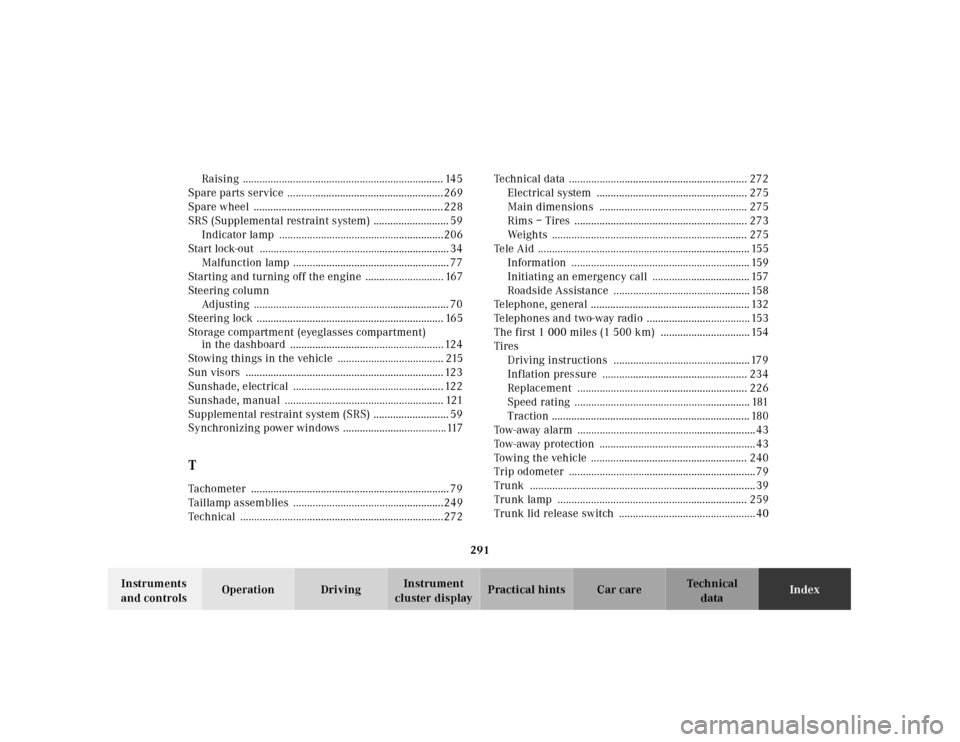
291
Technical
data Instruments
and controlsOperation DrivingInstrument
cluster displayPractical hints Car careIndex Raising ........................................................................ 145
Spare parts service ........................................................269
Spare wheel ....................................................................228
SRS (Supplemental restraint system) ........................... 59
Indicator lamp ...........................................................206
Start lock-out .................................................................... 34
Malfunction lamp ........................................................ 77
Starting and turning off the engine ............................ 167
Steering column
Adjusting ...................................................................... 70
Steering lock ................................................................... 165
Storage compartment (eyeglasses compartment)
in the dashboard ....................................................... 124
Stowing things in the vehicle ...................................... 215
Sun visors ....................................................................... 123
Sunshade, electrical ...................................................... 122
Sunshade, manual ......................................................... 121
Supplemental restraint system (SRS) ........................... 59
Synchronizing power windows .....................................117
TTachometer ....................................................................... 79
Taillamp assemblies ......................................................249
Technical .........................................................................272Technical data ................................................................ 272
Electrical system ...................................................... 275
Main dimensions ..................................................... 275
Rims – Tires .............................................................. 273
Weights ...................................................................... 275
Tele Aid ............................................................................ 155
Information ................................................................ 159
Initiating an emergency call ................................... 157
Roadside Assistance ................................................. 158
Telephone, general ......................................................... 132
Telephones and two-way radio ..................................... 153
The first 1 000 miles (1 500 km) ................................ 154
Tires
Driving instructions .................................................179
Inflation pressure .................................................... 234
Replacement ............................................................. 226
Speed rating ............................................................... 181
Traction ....................................................................... 180
Tow-away alarm ................................................................43
Tow-away protection ........................................................ 43
Towing the vehicle ........................................................ 240
Trip odometer ...................................................................79
Trunk .................................................................................39
Trunk lamp .................................................................... 259
Trunk lid release switch ................................................. 40